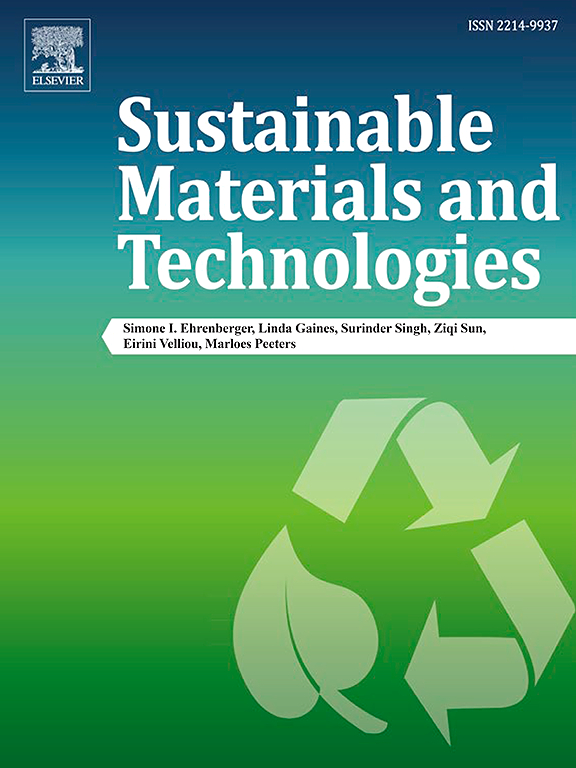Advancing circular battery recycling by systematically screening novel deep eutectic solvents for sustainable metal recovery
IF 8.6
2区 工程技术
Q1 ENERGY & FUELS
引用次数: 0
Abstract
The need to conserve resources and recycle spent lithium-ion batteries (LIBs) has become more urgent due to their increasing use in portable electronics and electric vehicles. This study proposes a unique approach involving computational screening and experimental validation to develop deep eutectic solvents (DESs) for recycling LIB cathodes. Using the conductor-like screening model for real solvents (COSMO-RS), 675 potential combinations of DESs were analyzed to identify the best DES constituents for the extraction of lithium and cobalt. Based on the screening results, eight promising DESs were synthesized from green and biocompatible materials such as glycine, betaine, carnitine, vitamin C, and citric acid. The synthesized DESs were evaluated for their potential to cause metal leaching from lithium cobalt oxide (LCO) cathodes. The combination of tetrabutylammonium chloride and vitamin C (TVW), as well as glycine and vitamin C (GVW), achieved almost complete recovery (>99 % Li, >98 % Co) in only 2 h at a temperature of 80 °C. The DESs have proven their reusability in seven successful recycling runs, enabling the selective recovery of high-purity lithium and cobalt oxalates. The environmental and economic impact of the DES-based process was evaluated, and its potential as a sustainable and cost-effective solution for large-scale LIB recycling was highlighted. This computational-experimental framework facilitates the discovery of environmentally friendly solvents. The methodology follows the principles of green chemistry and engineering while providing practical solutions for resource conservation and sustainable transformation. This will contribute to the development of recycling technologies and the circular economy in the fast-growing energy storage sector.

通过系统筛选新型深共晶溶剂推进循环电池回收,实现金属的可持续回收
由于锂离子电池(lib)在便携式电子产品和电动汽车中的使用越来越多,对其进行资源节约和回收的需求变得更加迫切。本研究提出了一种独特的方法,包括计算筛选和实验验证,以开发用于回收LIB阴极的深共晶溶剂(DESs)。采用真实溶剂类导体筛选模型(cosmos - rs),分析了675种可能的DES组合,以确定提取锂和钴的最佳DES组分。在筛选结果的基础上,以甘氨酸、甜菜碱、肉碱、维生素C和柠檬酸等绿色和生物相容性材料合成了8种有前景的DESs。对合成的DESs进行了评估,以评估其从锂钴氧化物(LCO)阴极中导致金属浸出的潜力。在80℃的温度下,四丁基氯化铵和维生素C (TVW)以及甘氨酸和维生素C (GVW)的组合在2小时内几乎完全回收(99% Li, 98% Co)。在七次成功的循环利用中,DESs已经证明了其可重复使用性,能够选择性地回收高纯度的锂和草酸钴。评估了基于des的工艺的环境和经济影响,并强调了其作为大规模LIB回收的可持续和经济解决方案的潜力。这种计算实验框架有助于发现环境友好型溶剂。该方法遵循绿色化学和工程的原则,同时为资源节约和可持续转型提供切实可行的解决方案。这将有助于在快速增长的储能领域发展回收技术和循环经济。
本文章由计算机程序翻译,如有差异,请以英文原文为准。
求助全文
约1分钟内获得全文
求助全文
来源期刊

Sustainable Materials and Technologies
Energy-Renewable Energy, Sustainability and the Environment
CiteScore
13.40
自引率
4.20%
发文量
158
审稿时长
45 days
期刊介绍:
Sustainable Materials and Technologies (SM&T), an international, cross-disciplinary, fully open access journal published by Elsevier, focuses on original full-length research articles and reviews. It covers applied or fundamental science of nano-, micro-, meso-, and macro-scale aspects of materials and technologies for sustainable development. SM&T gives special attention to contributions that bridge the knowledge gap between materials and system designs.
 求助内容:
求助内容: 应助结果提醒方式:
应助结果提醒方式:


